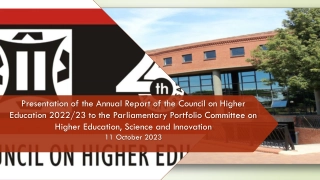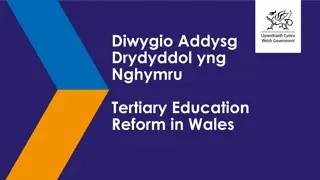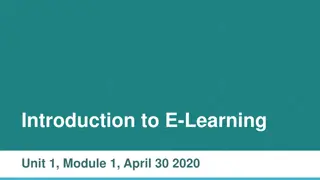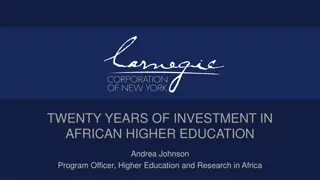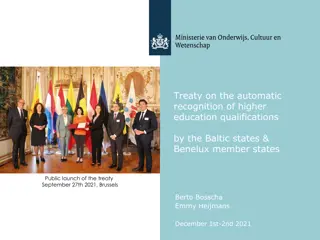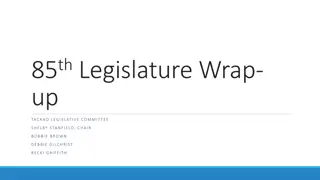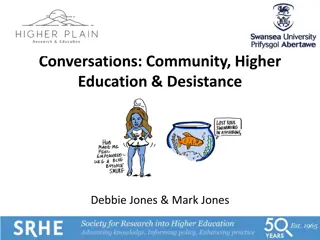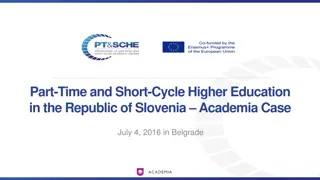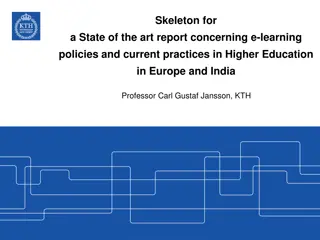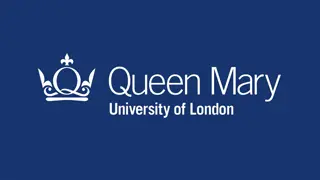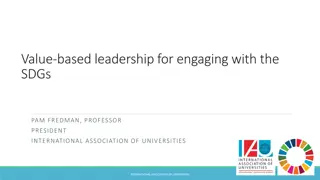Higher education as a common good
Research on higher education highlights its impact on employment, health, technology skills, social trust, and personal agency. It discusses individual and collective benefits, emphasizing global mobility, cultural diversity, and contributions to society.
Uploaded on Feb 26, 2025 | 1 Views
Download Presentation

Please find below an Image/Link to download the presentation.
The content on the website is provided AS IS for your information and personal use only. It may not be sold, licensed, or shared on other websites without obtaining consent from the author.If you encounter any issues during the download, it is possible that the publisher has removed the file from their server.
You are allowed to download the files provided on this website for personal or commercial use, subject to the condition that they are used lawfully. All files are the property of their respective owners.
The content on the website is provided AS IS for your information and personal use only. It may not be sold, licensed, or shared on other websites without obtaining consent from the author.
E N D
Presentation Transcript
IIEP Strategic debate, UNESCO, 12 March 2018 Higher education as a common good Simon Marginson Director of the ESRC/HEFCE Centre for Global Higher Education Professor of International Higher Education UCL Institute of Education University College London, UK
Worldwide growth of enrolment in tertiary education since 1970 7 Tertiary education enrolment 6.2 6 5 4 3 Real GDP 3.6 2 1.0 Population 1.9 1 0 1970 1971 1972 1973 1974 1975 1976 1977 1978 1979 1980 1981 1982 1983 1984 1985 1986 1987 1988 1989 1990 1991 1992 1993 1994 1995 1996 1997 1998 1999 2000 2001 2002 2003 2004 2005 2006 2007 2008 2009 2010 2011 2012 2013 tertiary education students world population
Research finds that people who achieve higher education, on average Have a larger range of employment options Are more likely to be in good health, as are their families Have more advanced skill in the use of information and communications technology (electronic agency) Are more geographically mobile, independent of income level (personal confidence and agency freedom) Report higher levels of inter-personal trust (also = greater personal agency) Are more likely to state that they have a say in government (also = greater personal agency) Are more positive about migration and cultural diversity - Walter McMahon, Higher Learning, Greater Good (2009); OECD, Education at a Glance (2015); OECD, Perspectives on Global Development 2017: International migration in a shifting world (2016) etc
Individual or collective benefit? Both? individualised 1 Individualised national goods Greater agency freedom 2 Individualised global goods Cross-border mobility and employability Better social position Communications facility Augmented earnings and employment rates Knowledge of diverse languages and cultures Lifetime health and financial outcomes, etc Access to global science national global 3 Collective national goods Ongoing development of professions/occupations 4 Collective global goods Universal global science Diverse knowledge fields Shared social literacy, opportunity structure Common zone of free critical inquiry Inputs to government Systems for exchange, collaboration, mobility Stronger regions, cities collective
How do we understand, monitor and enhance these outcomes? Using public good and common good 1. Is the public/private line a distinction between - non-market or market forms of education (economic distinction), - state or non-state controlled forms of education (juridical- political distinction)? 2. What if anything is normatively good about public goods in higher education? 3. Does higher education as a common good provide a more useful policy framework than public good ?
Economic definition of public/privatebased on market vs. non-market production Samuelson (1954) Public goods are non-rivalrous and/or non excludable. They are under-produced or unproduced in economic markets. All other goods are private goods
Economic public goods: non-rivalrous and non-excludable Goods are non-rivalrous when consumed by any number of people without being depleted, e.g. knowledge of a mathematical theorem, sustains use value everywhere, globally, indefinitely, on the basis of free access Goods are non-excludable when benefits cannot be confined to individuals, e.g. clean air regulation, defence Private goods are neither non-rivalrous nor non-excludable. They can be produced, sold and bought as commodities in economic markets. This public/private distinction is between non-market production and market production Research is primarily a public good. Teaching/student places can be either public or private; depends on policy The economic definition draws attention to goods which are subject to market failure (such as educational equity)
Political definition of public and private state vs. non-state The line between public and private is to be drawn on the basis of the extent and scope of the consequences of acts which are so important as to need control, whether by inhibition or by promotion The public consists of all those who are affected by the indirect consequences of transactions Matters with consequences for others include market transactions, organisation of education systems, etc This public/private distinction is between state-controlled and non-state controlled production Public goods are whatever the state (or democratic communities) say they are. Arbitrary, eclectic, but flexible! ~ John Dewey, The Public and its Problems, 1927, pp. 15-16
Putting the two definitions together The economic distinction is non-market vs market The political distinction is state vs non state In the economic definition higher education is public, unless produced in a market outside the state. In the political definition public or private is decided by states or democratic communities The economic and political definitions each have virtues, but also gaps. Each is ambiguous Putting them together creates four unambiguous categories (four political economies) that can be used to explain higher education and research
Public and private goods: four political economies of higher education Non-market goods Quadrant 2: SOCIAL DEMOCRACY Quadrant 1: CIVIL SOCIETY Teaching: Free places, low value differentials Teaching: Private learning in Internet, libraries Research: Publicly funded, integral to researcher Research: Self-made scholarship and inquiry State sector goods Non-state sector goods Quadrant 4: COMMERCIAL MARKET Quadrant 3: STATE QUASI-MARKET Teaching: Commercial market in tuition/degrees Teaching: Quasi market in student places/degrees Research: State quasi- market, product formats Research: Commercial research and consultancy Market- produced goods NOTE: State, institutions and individuals are active agents in all four quadrants
Common good(s) Not all public goods are necessarily progressive in distribution or social effects (aggressive national military offensives are a public good in both the economic and political senses, but do we like them?) Collective relational goods are a particular kind of non- market good, public goods in the economic sense. These are relational goods that provide for social solidarity, equity, human rights, democratic self-determination, and social and geographic mobility (freedom of movement) in populations The normative term common good and common goods may serve to describe such collective benefits The provision of higher education on the basis of equal social opportunity is an important common good
Factors that create opportunity hierarchies Elite schools and school sectors that shape selection Fields of study attached to differential social rewards Horizontal institutional diversity (mission, type) that becomes vertical (hierarchy of value), e.g. distinction between university and non-university institutions Public and private sector distinction can be a hierarchy Tuition barriers and differentiated tuition prices Intensified competition between institutions Differentiated student aspirations
Applying common good The common good idea provides a better normative basis than public good for tackling stratification The common good approach is a non-market approach (commercial markets generate financial closures and inequalities which are the antithesis of the common good) It is not necessarily a state-based approach. It allows a larger group of actors to contribute to education, and is compatible with mixed financing (with safeguards!) BUT by-passing states altogether does not work well especially if it lets the commercial market in. Arguably, private sectors in education work best when there is effective state regulation, e.g. South Korea
Complication 1 Whose common/public goods? Are there generic common goods in higher education? Is there a really generic/worldwide common good in higher education? Or is common or public good just in the eye of the beholder and incapable of generic form ? Whose common good is it? Which tradition of state , public and common should we use Anglo-American, Nordic, German social market, Chinese, Latin American, etc? Or should we use a combined idea, based on a reasoned synthesis? Most global strategies are not really global but reflect one or another national viewpoint
National variations in public and common United States Nordic Post-Confucian (East Asia and Singapore) Nation-state Limited liberal state, federal, separate from economy and civil order, constraints on state intervention. HEIs in civil society? Comprehensive Nordic welfare state, unitary, equated with society, fosters cooperative and egalitarian HEIs Comprehensive Sinic state, politics commands economy. Unitary. High status state (top graduates enter state service) Educational culture Meritocratic and competitive market. Highly stratified, but education seen as common road to wealth/status within advancing prosperity Egalitarian, free of charge, cooperative, universal, public. Low stratification of HEIs. State guaranteed medium for equal opportunity Education for filial duty and social status in stratified system. Confucian commitment to self-cultivation at home plus state belief in economic benefits. State and family role in higher education State frames hierarchical market and steps back. Middle class family increasingly invests private resources State supervises high quality egalitarian provision. Autonomy of HEIs. Family citizen right to free education State supervises, shapes and drives the sector. Managed autonomy. Family invests much energy, time, money
Complication 2 What about global public/ common goods? Global public goods are goods that have a significant element of non-rivalry and/or non-excludability and made broadly available across populations on a global scale. They affect more than one group of countries, are broadly available within countries, and are inter-generational; that is, they meet needs in the present generation without jeopardizing future generations. ~ Inge Kaul, I. Grunberg and Marc Stern (Eds.), Global Public Goods: International cooperation in the 21st century, New York, Oxford University Press, 1999, pp. 2 3
Common ground on common goods? Common goods pertaining to human rights, social solidarity and equality, intercultural cooperation and international understanding, might be among the generic common goods in higher education. Also certain global common goods - - communications and mobility between universities - research knowledge in all disciplines - networked space for free inquiry and learning Who pays for global common goods? A key problem at world level is that it needs a state to maximise distributional equity of global public or common goods and there s no global state
Closing points 1. Both the state/non-state and non-market/market distinctions are relevant, and can be combined. Together they provide a useful explanation, but not a policy 2. Economic public good in higher education provides a financing equation, but there is a danger of elite capture 3. Common goods (goods that sustain sociability on the basis of equality and rights) have a special importance 4. Common good in higher education is useful, but there is danger of market capture and fragmentation. (Strategies based on by-passing bad states mostly do not end well) 5. The issues are specific to national political and educational cultures. State role varies in these cultures 6. Global common goods in higher education are under- recognised and need more explicit attention
SUMMARY Higher education is a common good and a (state) public good - See also Rita Locatelli, Education as a public andcommon good , UNESCO Education and Research Foresight, Working Papers 22, February 2018 Higher education is not always provided and financed by states, but part of the remit of the state is to ensure that all (economic) public goods subject to market failure are adequately financed These goods include human rights, freedoms, equality and solidarity in higher education; and research and scholarship in the different fields of knowledge
Thank you for listening (I hope it wasn t too dull!) s.marginson@ucl.ac.uk www.researchcghe.org


